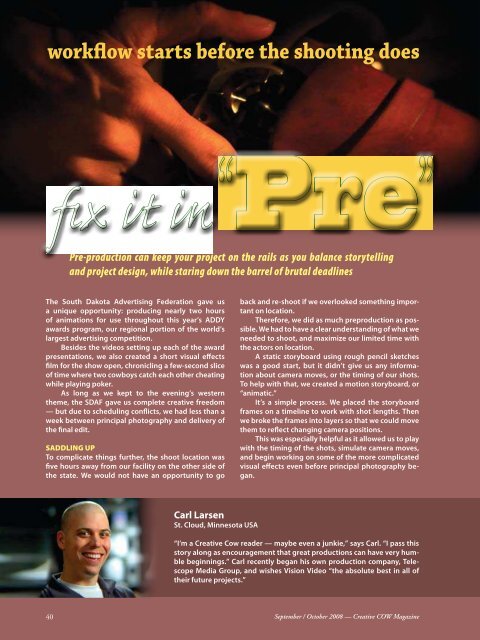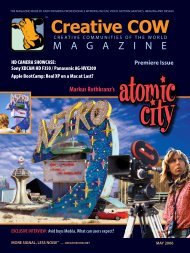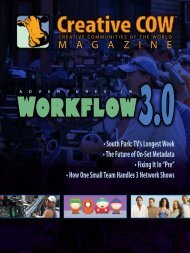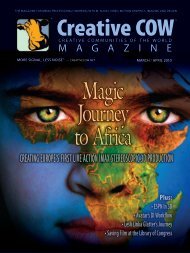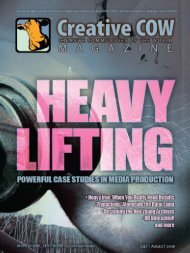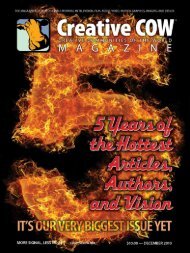Create successful ePaper yourself
Turn your PDF publications into a flip-book with our unique Google optimized e-Paper software.
Pre-production can keep your project on the rails as you balance storytelling<br />
and project design, while staring down the barrel of brutal deadlines<br />
The <strong>South</strong> Dakota Advertising Federation gave us<br />
a unique opportunity: producing nearly two hours<br />
of animations for use throughout this year’s ADDY<br />
awards program, our regional portion of the world’s<br />
largest advertising competition.<br />
Besides the videos setting up each of the award<br />
presentations, we also created a short visual effects<br />
film for the show open, chronicling a few-second slice<br />
of time where two cowboys catch each other cheating<br />
while playing poker.<br />
As long as we kept to the evening’s western<br />
theme, the SDAF gave us complete creative freedom<br />
— but due to scheduling conflicts, we had less than a<br />
week between principal photography and delivery of<br />
the final edit.<br />
SADDLING UP<br />
To complicate things further, the shoot location was<br />
five hours away from our facility on the other side of<br />
the state. We would not have an opportunity to go<br />
Carl Larsen<br />
St. Cloud, Minnesota USA<br />
back and re-shoot if we overlooked something important<br />
on location.<br />
Therefore, we did as much preproduction as possible.<br />
We had to have a clear understanding of what we<br />
needed to shoot, and maximize our limited time with<br />
the actors on location.<br />
A static storyboard using rough pencil sketches<br />
was a good start, but it didn’t give us any information<br />
about camera moves, or the timing of our shots.<br />
To help with that, we created a motion storyboard, or<br />
“animatic.”<br />
It’s a simple process. We placed the storyboard<br />
frames on a timeline to work with shot lengths. Then<br />
we broke the frames into layers so that we could move<br />
them to reflect changing camera positions.<br />
This was especially helpful as it allowed us to play<br />
with the timing of the shots, simulate camera moves,<br />
and begin working on some of the more complicated<br />
visual effects even before principal photography began.<br />
“I’m a <strong>Creative</strong> Cow reader — maybe even a junkie,” says Carl. “I pass this<br />
story along as encouragement that great productions can have very humble<br />
beginnings.” Carl recently began his own production company, Telescope<br />
Media Group, and wishes Vision Video “the absolute best in all of<br />
their future projects.”<br />
From top: storyboard with final shot; example of shallow depth of field<br />
We also did several camera tracking tests and<br />
mock shoots in our studio, which proved to be invaluable.<br />
Because we planned to shoot everything overcranked<br />
at 60fps, it was all the more essential to have a<br />
strong understanding of how the edit was going to fit<br />
together before the shoot began.<br />
Thanks to our extensive pre-planning, we knew<br />
the length of each shot, the camera’s perspective and<br />
movement, and even had a music score in place before<br />
we ever rolled camera in Deadwood.<br />
HITTING THE TRAIL<br />
As we went into the project, our goal was to create a<br />
realistic effects film with high production values that<br />
drew attention to the story, and not the effects themselves.<br />
The production involved 2 days of shooting, 5 actors,<br />
2 locations, 14 visual effects shots, and a very limited<br />
budget, using a team of just the 3 of us at Video<br />
Vision: Cody Redmer (previz, editor, lead compositor,<br />
camera/DP, sound design); Dan Bruns (previz, crewing,<br />
location scouting, assistant camera); and me (VFX supervisor,<br />
assistant compositor).<br />
We shot with a Panasonic<br />
HVX-200 in 720p HD mode at<br />
23.976 fps, using a Cinemek<br />
Guerilla-35 depth of field converter<br />
and Nikon f1.8 primes.<br />
The “G35” is an HD 35mm<br />
adapter still under development<br />
as I write this. Its most attractive<br />
feature is that it has a<br />
static imaging plane and does<br />
not require power. As a result,<br />
it’s a simple, lightweight, and<br />
compact unit that is very friendly<br />
to off-speed shooting.<br />
Since ours was a beta model,<br />
one of the biggest challenges<br />
was that it lost a significant<br />
amount of light — I estimate<br />
about 4 stops. (The newest production<br />
versions are said to lose<br />
only 1.4 stops.)<br />
Nevertheless, it afforded<br />
us the ability to mount 35mm<br />
Nikon lenses on our camera.<br />
This provided the beautifully<br />
shallow depth of field and extreme<br />
focus pulls seen throughout<br />
the film.<br />
We also used various camera<br />
support systems, including<br />
a home-made dolly system, and<br />
a 10 foot Advanta-jib with pan<br />
and tilt.<br />
Editing was done in Final<br />
Cut Pro, visual effects were handled<br />
in After Effects, and music<br />
was scored in Reason.<br />
Here are a couple of examples of the way we put<br />
the pieces together to tell our story.<br />
THE RAIN SHOT<br />
The only shot which we had essentially completed before<br />
principal photography turned out to be one of the<br />
most impressive. It appears at the middle of the film,<br />
just after a muzzle flash leaves the audience wondering<br />
which cowboy has just fired his gun.<br />
The camera starts far above a saloon in a heavy<br />
40 September / October 2008 — <strong>Creative</strong> <strong>COW</strong> <strong>Magazine</strong><br />
<strong>Creative</strong> <strong>COW</strong> <strong>Magazine</strong> — September / October 2008 41


